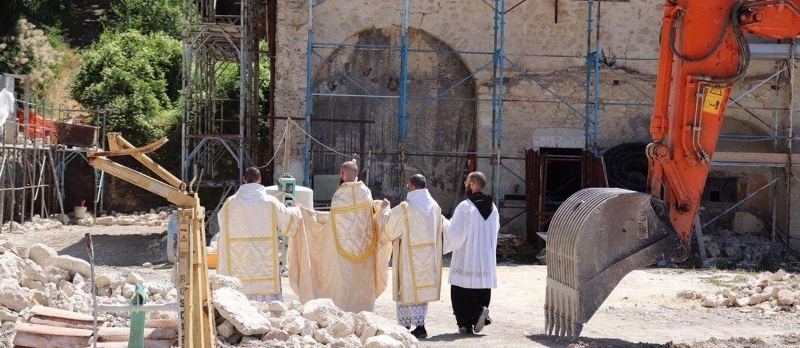 OTHER
OTHER
The double rebirth of Norcia: New Monastery and reconstruction of the ancient Basilica "as it was and where it was"
Norcia. From the PERUGIA TODAY portal (21 March 2020) we learn with joy from the mayor of Norcia, Nicola Alemanno, that the ancient Benedictine basilica in the city center will be rebuilt "as it was and where it was". The news was announced by in a video message by the mayor on the Municipality website and partially mitigates the disappointment for the coronavirus induced cancellation of the traditional celebration for the feast of the patron saint, St. Benedict, on March 21st in Norcia and related events, such the arrival of the runners who every year on this day converge to Norcia after the 310 km “Cammino di San Benedetto” (St. Benedict trail), an itinerary that unfolds from the Abbey of Montecassino in Cassinoto Norcia, passing through Subiaco, the three main places of the Saint’s apostolate. Likewise, it was not possible to turn on the tripod that was supposed to receive the Pro Pace torch this year on pilgrimage in Hungary, in Budapest, from February 27 to March 2.
"The Basilica will be rebuilt as it was and where it was”, said the Mayor, disclosing that he was informed by Ministry for cultural assets and activities that the bid for the reconstruction of the Basilica had been sent to the ANAC, the National Anti-Corruption Authority. “St. Benedict will not deprive us of his protection as he has done thus far…Happy Feast of Saint Benedict to all ... and stay at home!".
The Mayor was in the front row among the religious and civil authorities also on another occasion: the laying of the first stone
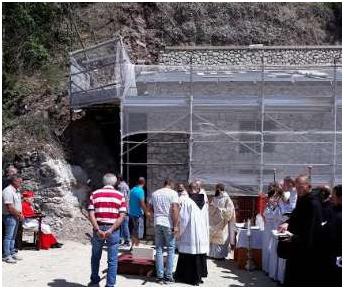 of the new monastic complex for the Benedictine community after the earthquake, the 20th anniversary of its refoundation and the feast day of San Benedetto, patron of Europe.
of the new monastic complex for the Benedictine community after the earthquake, the 20th anniversary of its refoundation and the feast day of San Benedetto, patron of Europe.
Alas, to a large extent the scars caused by the 2016 earthquake are still there. As reported in the major national news agency ANSA, on July 18th, 2019, the President of Italy Sergio Mattarella called upon the competent authorities to speed up the reconstruction of the town of Amatrice and all areas in central Italy hit by earthquakes three years ago.
"The dream of reconstruction must … go forward on all fronts to … remove the mark of precariousness", he was quoted as saying during a visit to the RomoloCapranica campus in Amatrice. "The future of Italy is at stake here. But we must act quickly," the president said in response to an appeal by a student who had said that she dreamed of "going back to living in real homes".
We do not know if it is a coincidence, but this appeal follows similar, bitter remarks of the archbishop of Spoleto-Norcia, Msgr. Renato Boccardo, who lamented that "too many promises" had not been fulfilled. "The feeling of having been abandoned is very strong", he declared during an interview with Vatican Radio Italy (11 July 2019), "Unfortunately reconstruction, and we know it, is slowly coming about and the bureaucracy makes more victims than the earthquake".
Even amid these bleak circumstances, however, the prelate also mentioned some "signs of restart", such as the blessing of the first symbolic stone of the Monastery of San Benedetto in Monte. And in fact, Msgr. Boccardo had been interviewed precisely on the occasion of the above laying of this foundation stone of the new Benedictine monastery in Norcia.
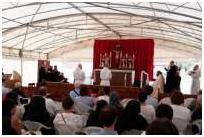
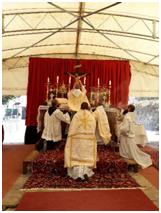 The two-day event, which took place on 10-11 July 2019 andcoincided, as already said, with the first 20 years of the Benedictine community in Norcia and the feast of Saint Benedict, patron of Europe, was marked by four highlights: Vespers in the evening of 10 July; a conference by the prior Father Benedetto Nivakoff to present the first 20 years of the monastery with the latest developments and plans for the future; the solemn mass of the following day;
The two-day event, which took place on 10-11 July 2019 andcoincided, as already said, with the first 20 years of the Benedictine community in Norcia and the feast of Saint Benedict, patron of Europe, was marked by four highlights: Vespers in the evening of 10 July; a conference by the prior Father Benedetto Nivakoff to present the first 20 years of the monastery with the latest developments and plans for the future; the solemn mass of the following day;
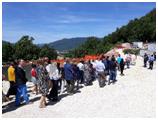 and the procession with the relic of the patron saint culminating in the ceremony for the laying of the first stone in the containment wall of the new monastery of San Benedetto in Monte on a former capuchin convent. Behind this stone, in addition to the relic of the Saint, was also cemented in perennial custody the dedication letter of the prior in which he celebrates this truly unique day.
and the procession with the relic of the patron saint culminating in the ceremony for the laying of the first stone in the containment wall of the new monastery of San Benedetto in Monte on a former capuchin convent. Behind this stone, in addition to the relic of the Saint, was also cemented in perennial custody the dedication letter of the prior in which he celebrates this truly unique day.
The two days, open to all, saw the participation of many "Nursini", citizens of Norcia, together with representatives of the hierarchy, such as Msgr. Boccardo, Cardinal Walter Brandmüller, and many religious men and women, along with the civil authorities such as the mayor of Norcia Nicola Alemanno and the former governor of the Umbria region Catiuscia Marini and many faithful not only from Norcia, but from the rest of Italy and also abroad for this special occasion. The Mayor, speaking at the local news portal Umbria24, said that this is a "historic moment for Norcia and for the whole of Umbria. The construction of the new monastery - he added – further cements the bond between the city and its monks and places this territory at the center of Europe, whose patron our saint is». In a previous comment he was quoted as saying to the Umbrian online daily Tuttoggi that the bond between the monks and his fellow citizens is “indissoluble”, wishing for the work of the monks to represent “the guiding light for the New Europe”.
The concept hinted at by Msgr. Boccardo, that is the construction of the new monastery as a powerful sign of hope after the tragedy of the earthquake, was elaborated on by Father Nivakoff in his speeches, including the motivation for the adoption of a new motto.
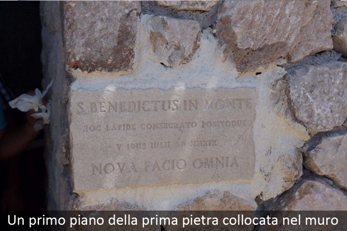 In fact, on June 12, the monastery celebrated 20 years since its canonical founding in 1999. For this historic anniversary, it seemed right to father Nivakoff to finally add a motto to the crest of the monastery: Nova Facio Omnia (“I Make All Things New”). A motto which was also carved on the foundation stone inserted into the wall of the monastery under construction.
In fact, on June 12, the monastery celebrated 20 years since its canonical founding in 1999. For this historic anniversary, it seemed right to father Nivakoff to finally add a motto to the crest of the monastery: Nova Facio Omnia (“I Make All Things New”). A motto which was also carved on the foundation stone inserted into the wall of the monastery under construction.
As explained by the prior, the verse is taken from the Book of the Apocalypse (Chapter 21, verse 5) and describes the New Jerusalem in all its splendor. “I believe this verse captures both the spirit of our first twenty years and provides an orienting principle for the future”, he said. “The search for what is new springs from the deep desire in the human heart for New Life, untouched by Original Sin”.
Newness and youth go together, he went on, bringing joy to the soul which has yet to experience some of the harsher realities of life. “The Church herself calls us always to renew that youthfulness, beginning the Mass with a reminder of how God blesses youth with joy: Ad Deum qui laetificatjuventutemmeam (To God who gives joy to my youth). Sin makes us old, taking away our innocence and joy”.
As a matter of fact, the dimension of “Newness” is a recurrent feature in the somewhat short life of the congregation. As recalled in an interview by father Cassian Folsom, re-founder of this Benedictine congregation and its first prior until father Nivakoff took over in 2016, from the various paths tried for the canonical recognition of the initial Benedictine community formed by himself and three other postulants, Providence chose a completely new path and in a very short time. To sum it up, a “special miracle” which “gave me confidence that God was giving us His blessing”. And thus, “on June 12, 1999 the formal decree arrived placing us among illustrious monasteries of the Benedictine Confederation, but outside a specific congregation”.
Monasteries are normally founded from an older existing monastery which makes a new foundation. We tried this, he said, but Providence suggested a fresh start, exactly as stated by our new motto Nova Facio Omnia.
Monastic life needed then and still needs now a renewal, he pointed out. “By renewal, I mean not just returning to the spirit of St. Benedict, but to the Rule of St. Benedict, to the actual way of life that he outlined. And it’s much easier to start something new than it is to renew something that existsalready…That’s why we took the risk to start something new; it seemed like the very best path to follow”.
And so we began with very clear principles, the father continued, but less clarity about how they would actually take form. “So, the forms have changed over the years, but the principles have remained the same. For example, we started in a little apartment, not in an established monastery. We started in Rome, not in Norcia. The first idea was that our community would serve St. Anselm in Rome, but that changed after 2 years. We came to Norcia, to the birthplace of St. Benedict, and for the first 16 years lived at the basilica and our main apostolic work was to serve the pilgrims who came to visit”.
But the earthquake has again changed the situation, transforming that service into a more spiritual and supernatural one. “The post-earthquake experience is almost like a re-founding of the monastery with the same principles but a slightly different form”. In other words, “over these 20 years, things have changed a great deal. The principles have remained the same, but the form has evolved to what it is now”. Whereas before the monks were in the middle of the city, now they are dwelling on a hill overlooking the city, with a great gain in terms of silence, solitude and separation from the world. “The reconstruction project allows us to build the monastery according to the needs of the community, which after so much time are now quite clear”, he emphasized.
An assumption reiterated by Father Nivakoff in his lecture after Vespers. In fact, in his search for God, the Lord made Saint Benedict accept the most varied and unexpected circumstances and find in them the way to salvation. "Reflecting on our first 20 years we cannot fail to find a similar situation," he noted. "It is the beautiful blindness that God gives to those who seek Him by hiding future labors so as not to discourage them."
In the 16 years spent in the city, he continued, we realized that the treasure that the saint had, the treasure to be preserved and possibly offered, was not culture, was not even the famous peace ... "The treasure that the Saint has kept and wanted us to cherish is faith”.
The events of the August 2016 earthquake were clear signs for us, he went on. "Faith is under attack not only by external forces, but also from within the Church just as then, when they had to defend themselves from Arianism inside and from barbarians outside. And it is in these circumstances of total collapse that the Saint has decided to plant and root, building not a walled building ... but rebuilding people”. St. Benedict was a father, in the true sense of the word, in that "he generated new life in his monks by giving them Jesus Christ, the beginning and creator of life itself".
Even if we hope to rebuild the beautiful Capuchin convent in the next three years and reopen the adjacent church by mid-2020, our hope is not based on that, Father Nivakoff pointed out.
Yes, the community is growing, he disclosed, but the future cannot be secure regarding these great projects. "It is God who guides history and not us. If we want to be monks and true sons of Saint Benedict, we cannot forget the true goal that is not a place, but a person, God. We are sure that for now God wants us here, in
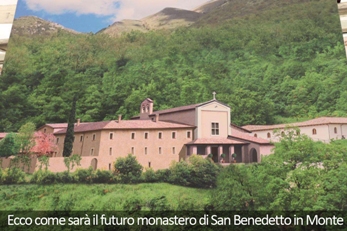 San Benedetto in Monte , to live together and accept the mystery of his providence, to make room for God and not to take His place”.
San Benedetto in Monte , to live together and accept the mystery of his providence, to make room for God and not to take His place”.
The interventions of Father Nivakoff continued with his homily during the solemn mass of 11 July, a lectio magistralis on the spirituality of the Saint inspired by the epistle in his feast day. "Today's epistle says that the life of St. Benedict is like music," he began. "The memory of the saint is like music that accompanies a banquet where wine is not lacking, and joy is palpable". While the feast of March 21 commemorates the passage of the Saint to his blessed eternity, the feast of July 11 "has been seen for centuries as an appreciation of the earthly part of the life of the Saint, the many miracles, his perennial wisdom, all that which made him not just an ordinary person, not a normal person. In fact, by definition a saint is close to God in a way that already in this world he behaves like God", and therefore in essence he is a reflection of the living image of God.
Faith is intimately linked to the taciturnitas (taciturnity), which is one of the three pillars of the Benedictine rule and spirituality, together with obedience and humility.
"The age in which we live has lost patience for this taciturnitas and has filled it with explanations, words, noises. When we monks after the earthquake believed we accepted the indication of the providence to plant the roots of the new monastery here, it was with fear and hesitation: Like many of you we asked ourselves: but what will happen, how will we be able to live ... God knows the answers and will make us understand at the right time. "
Unable to tolerate this state of uncertainty and insecurity any longer, "the modern secular world seeks with technological, political or commercial solutions to deprive us of the pain that the mystery of faith requires", because it is in fact "only in the possibility of doubt that one can grow in faith. God has left us free precisely because we will be happier in choosing Him than in not having any choice. From within the Church in the past century, there has been a strong pressure to remove from the Christian the obligation of living with the uncertainty; better to change a rule than leave someone in doubt about their salvation. Various attempts to ease the weight of faith have just the opposite effect: man becomes less free and consequently less happy”.
The music that accompanied the life of the saint, as the epistle says, therefore “is not any music. Like the Gregorian chant, which is the fruit of the monk's prayer, and not just its cause or its means, the music that has surrounded his life and which could also surround ours is the result of a state of heart where the taciturnitas reigns”.
The construction of the monastery and the reopening of the church in Monte, therefore, "will not in themselves bring music, they do not solve problems, but if we see in it the path of faith … music and wine will be there and this will open a door to heaven from here“.
In addition to Norcia, in Italy St. Benedict was also celebrated in other places related to his life, such as Monte Casino, Subiaco and in the territorial abbey of Monte Oliveto Maggiore in Siena. In the rest of Europe his memory was honored in the abbey of Solesmes in France, in that of Ettal in Bavaria, in Michaelbeuern and Seitenstetten in Austria, in Pannonhalma in Hungary, in Brevnov in the Czech Republic, in Engelberg in Switzerland and at Douai Abbey, near Upper Woolhampton in England.
Back to the news


